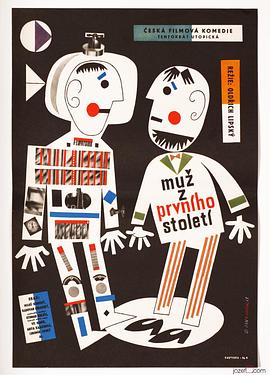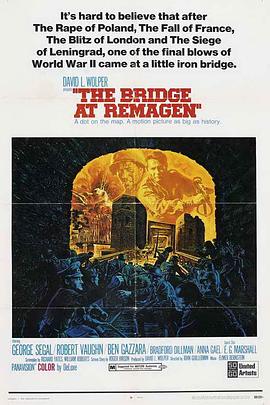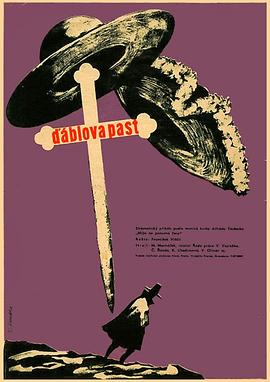主演的影片
1962
电影
/
喜剧片
其它
Anita
Anna
Bohumil
Bohumil
Cernohous
Doubrava
Frantisek
Helena
Hlavatý
Jirí
Kajlichova
Milos
Miroslav
Miroslav
Olmer
Pitasová
Rehor
Ruzicka
Ruzicková
Svarc
Vít
Zavrel
Zdenek
卡雷尔·哈布尔
卢博米尔·利普斯基
弗拉迪米尔·门西克
拉多万·卢卡夫斯基
欧托门·科雷查
米洛斯·科佩基
约瑟夫·赫利诺马兹
A workman is accidentally sent into outer space, where he meets an alien that can make himself invisible. They return to Earth in the year 2447. Complications ensue.
已完结
1969
电影
/
剧情片
美国
Anna
Braunschläger
E.G.马绍尔
Ford
Fritz
Gaël
Gottwal
Jahncke
Logan
Neuzil
Olmer
Richard
Robert
Rolf
Steve
T.
Václav
Vít
Zdenek
乔治·席格
博·霍普金斯
布拉福德·迪尔曼
弗兰克·韦伯
彼得·范·埃克
昆特·迈斯纳
本·戈扎那
汉斯·克里斯蒂安·布勒希
海因茨·莱纳克
索妮娅·齐曼
约阿希姆.汉森
罗伯特·沃恩
马特·克拉克
鲁道夫·耶利内克
网上关于这座桥的历史资料不甚详尽,关于影片的介绍更是简单的可怜,在看过的一些历史记录片中对这座桥大多也是寥寥几句带过——可是,希特勒曾说过这样一句话:“有两个“桥头堡”决定了我们德国的命运,一个在诺曼底,而另一个在雷马根!” 《雷玛根大桥》(Bridge at Remagen)——美国米高梅公司1969年拍摄;导 演:John Guillermin ;主 演:乔治·西格尔、本·吉扎拉、马歇尔等;片长115 分钟。 作为艺术作品,这部故事片加入了不少虚构的人物和情节,内涵相当丰富,想来许多朋友都已看过,国内还有译制版本,在下不多啰嗦...... 只是想为同样对这座桥或这部影片感兴趣的朋友提供些参考! 雷马根大桥被美军占领,“如同一把手术刀,在德国人的莱茵河防线上切开了一道口子!”河对岸镇守厄尔波尔镇的100多名德军工兵发起了自杀式的冲锋,几乎全部阵亡!德军的大炮猛烈轰击大桥和美军架设的舟桥,甚至出动了当时刚刚研制成功的喷气式飞机来炸桥,后来还发射了11枚V1飞弹,但令人不可思议的是这一切都没能奏效;与此同时,美军工兵夜以继日地拼命加固受损的桥身,保证大批步兵和坦克源源不断地挺进德国腹地——希特勒十分恼怒,下令所有与雷马根大桥失守有关联的人员,除一人外全部枪决! 雷马根鲁登道夫铁桥全貌 到三月六日,美第六军攻占科隆,从而在荷兰的涅米根到科隆之间一百多英里的区域形成了盟军首尾呼应的连续战线。科隆以南,德第五装甲集团军面对的是美第一和第三军,后者正快速突破德军阵地。当攻占科隆以后,美军没有满足已有的胜利。击溃德第五装甲集团军后,如果继续穷追猛打,很可能在德军休整前就将它们包围。目前这是可行的。三月七日,美第七军从科隆出发向波恩发起进攻,美第三军,则去夺取艾尔河上的桥梁。当天中午,美第七装甲师〔隶属美第三军〕的B战斗团听到一个振奋人心的消息:雷马根地区莱茵河上的鲁登道夫铁桥还未被德军炸毁。要完整地夺取该桥,这可是天赐良机。因此,美第七装甲师向雷马根扑去。下午,当美第七装甲师准备过桥时,对面的德军正要引爆炸桥,但未能成功,这样美第七装甲师成功的渡过了莱茵河,并建立了稳固的桥头堡。 巨大的桥头碉堡扼守着大桥两侧 此时,希特勒怒火中烧,开始对鲁登道夫铁桥实施轰炸,用火炮猛击,还从波恩调来德第十一装甲师及五一二独立重驱逐坦克营〔恩斯特和奥托·卡利欧斯指挥〕的“猎虎”,甚至动用了V-2火箭。直到三月十七日,该桥才被炸毁。但美军包括一个装甲师在内的六个师已在河东岸站稳了脚根。德第十一甲师和五一二重驱逐坦克营一直未能扭转战局,而原因是几乎没燃料,无法抵抗! 美第七装甲师通过雷马根鲁登道夫铁桥 靠南一些,巴顿的美第三军由于已抽出三个师编进了美第一军,只剩下十二个师〔其中三个是装甲师〕。到二月底,这些部队已基本肃清了齐格菲防线中心地带的德军,并向萨尔堡发起进攻。守卫萨尔堡的德第七集团军,十分顽强地抵抗,三月一日,终因供给不足而崩溃。两天后,即三月三日,美第五师抵达萨尔堡,这使美第四师能够猛扑波恩。三天后,美第四师已抵达科希伦茨附近的莱茵河边。三月十四日,美第七军的第四和第二十一装甲师从特雷斯被派往莱茵河战线。在四十八小时内,美第四装甲师只前进了三十二英里,因为美第四装甲师与正面的德第二装甲师打得难解难分。直到盖飞将军的军队增援,才使问题得以解决。至二十一日,美第四装甲师攻占了沃尔姆斯,美第九十师攻占美因茨,美第二十军继续向前推进,向路德维希港扑去。 南翼的美第七军与德第一集团军的战斗十分艰难。从三月十五日进攻开始到三月十九日,美军进展缓慢,美第三军在突破“西部防墙”防守十分坚固的地段时也遇到了困难。至二十四日美第七军才击溃德第一集团军,攻占了兰多。从三月二十二日晚到二十三日清晨,美第三军已在奥本海姆附近渡过了莱茵河,五千名美军已踏上莱茵河东岸。而蒙哥马利的军队就在其身后不远外,但当他军队过河时已是步其后尘了。 英军渡过莱茵河! 当凯塞元帅担任德军西线总司令部〔下辖B、G、H集团军群和第五装甲集团军〕新任司令时,美军在莱茵河东岸的雷马根已建立了相当紧固的桥墩头堡,但英第二十一军群〔从北到南依次由加拿大第一军、英第二军和美第九军组成〕还在西岸。英军为准备渡河做了长时间的工作,这对不拘小节的美国人来说显然太繁琐了。三月下旬,一切准备就绪,一支英军皇家特混舰队从安特卫普经比利时,荷兰和德国运河,把四十五艘陆艇和一批“野牛”两栖坦克到运到二十英里长的英第二十一军群战线上的十个渡河点。从三月二十日到二十二日,英担家空军和美第八、第九航空队出动了一万六千架次战机,对进攻地带及其远方补给线进行猛烈轰炸,投弹几乎达五万吨。从三月二十一日清晨到二十三日黄昏,莱茵河西岸长达七十五英里的堤岸上浓烟密布,借此来掩护盟军部队的调动和做最后的渡河准备。 三月二十三日到二十四日夜,英第二十一军群的三千门火炮向河对岸的德军阵地实施了猛击,同时第十五和第五十一师以及美第三十和第七十九师乘“野牛”两栖坦克开始渡河。二十五日拂晓,英第二十一军群已在河东岸建立了桥头堡。次日,盟军两千架滑翔机在战斗机的护航下运载着英第六空降师和美第十七空降师开始向河东岸仅五英里的明克思发动空降进攻,进攻取得了胜利。到二十四日晚,美第十七空降师已与英第七军取得联系,并完整地夺取了伊塞河上的桥梁,给盟军迅速不断地扩大桥头堡阵地提供了便利。德第八十四师在前有美军后有伞兵的堵截下最终被子歼灭,将近四千名德军被俘。在特雷斯渡河进的盟军也遇到了最顽强的抵抗——德军一个伞兵营顽固的坚守了三天,直至弹药不足才被迫投降。 ——感谢美国随军记者,他们在那样危险的环境中,竟然拍摄了那么多夺取雷马根大桥和加固桥梁的镜头!!! 由于主桥拱在德军的爆破中受到致命损伤,加之连续多日的人员车辆通过,大桥不堪重负。3月27日下午15:00,就在宣布大桥关闭不到一小时后,雷马根大桥轰然坍塌,造成当时正在执行维修任务的28名美国工兵死亡,另有63人受伤...... 战后许多年,人们经常可以看见布拉特吉老师——当年的大桥守卫者威廉.布拉特吉上尉独自徘徊在桥头残留的双塔下,长时间的沉思...... 片中很详尽地描述了当时的战争环境:那些镇守德国小镇、年老体弱的“人民风暴”队员、那独自在窗口向美军射击,被乱枪打穿的孩子——一位坚定的“希特勒青年团员”、那列车上满脸绝望的伤兵......德国当时已是兵败如山,连老人孩子都上了前线,这些情节在其它二战题材影片中表现的不多; 片中塑造了一系列生动的军人形象,给大家印象最深的当数那位英俊潇洒,足智多谋,喜欢摆弄精美烟盒的德国军官布莱恩少校,但他却是个地地道道的虚构人物!即便如此,他还是反映出了当时德国军人的尴尬处境——尤其是影片最后,布莱恩少校因为大桥失守被党卫军处决,临死前他叼着烟卷仰天叹道:“到底谁是我们的敌人啊?”令人心里为之一颤!
已完结
1962
电影
/
剧情片
其它
Belohoubek
Bílá
Cestmír
Chadimová
Frantisek
Hasek
Indingerová
Jirina
Jirí
Karla
Kazda
Kindl
Kovárík
Ladislav
Milan
Monika
Olmer
Randa
Vejrazka
Vlastimil
Vít
Vítezslav
伊里·弗斯塔拉
米罗斯拉夫·马哈切克
约瑟夫·赫利诺马兹
贝德里奇·卡兰
雅罗斯拉夫·毛奇卡
In the time of Counter-Reformation, a miller and his son come under investigation by a priest of the Inquisition, when rumors spread that their prosperity comes from working with the Devil. The Devil's Trap is a film directed by František Vláil, based on a novel by Alfréd Technik, adapted by František A. Dvorák and Miloš Kratochvíl. It was the first of three historical dramas that Vláil made during the Czech New Wave (technically he isn't really a part of the New Wave, however these films were made during the same era of artistic freedom), preceding his more well known Marketa Lazarová (1967) and Valley of the Bees (1968). Set in the late 16th Century during the Catholic Reformation, in the Moravian Karst, situated in what is now the Eastern Czech Republic, it tells the tale of a miller (Vítezslav Vejrazka), and his son Jan (Vít Olmer), who come under suspicion and are investigated by a Jesuit priest of the Inquisition (Miroslav Macháchek), when rumors of witchcraft are spread by the local regent (Cestmír Randa), who is jealous of the miller's prosperity and degree of respect among the local populace. As expected from Vláil, this film is a stunning experience all the way through. From the opening shot, an ominous manipulation of perspective with a close up of a mangled figure of Christ dominating the foreground against a tiny figure in black walking along the horizon, to the breathtaking confrontational finale inside the vast stalactite filled Karst caverns, it is a wonderful display of visual mastery. Maybe not quite as impressive as Marketa Lazarová, but still full of astonishing imagery. As seen from unique angles and distinct points of view which highlight the director's remarkable sense of awareness of framing, motion, and positioning on the emotional and dramatic tone of the scene. The most memorable being a repeated shot where the camera is suspended and launched with speed through the air towards the miller's door. The story here is a simple one and I would say more accessible than his later works. With a conventional structure emphasized as much by its plot and characters, than by its expressionistic cinematography or authentic historical detail. The events play out without much surprise, and there is a strong underlying, almost supernatural, mysterious aspect that is left unresolved, in fact barely explored, which is slightly disappointing, but only because it's so fascinating that I wish there was more. Acting is great all around. Particularly the villains Miroslav Macháchek as the priest, casting a sinister and imposing shadow wherever he goes, and Cestmír Randa as the weasel like regent behind all the persecution. While Vít Olmer brings a charismatic leading man presence in his role as the miller's son Jan, in love with the lovely orphan girl Martina (Karla Chadimová), who becomes a dangerous object of rivalry between Jan and other young men of the village. The film also features the evocative music of Zdenk Liška (perhaps the most prolific composer of the Czech New Wave). In this his second of eleven collaborations with Vláil, his compositions are used sparingly, but to great effect, complimenting but never overpowering a scene. The best example of which can be heard in an amazingly shot celebration and dance sequence at the end of the second act. The Devil's Trap might not be a masterpiece, but it is still a strong effort, with a fascinating straightforward story and a glorious historical setting captured beautifully by Vláil's unmistakable visual prowess. A fine work that would also be the perfect starter plate to prepare yourself for the challenging feast of Marketa Lazarová or The Valley of the Bees. It even has an easy to digest running time. It's therefore puzzling why this gem remains largely overlooked and ignored.
已完结




